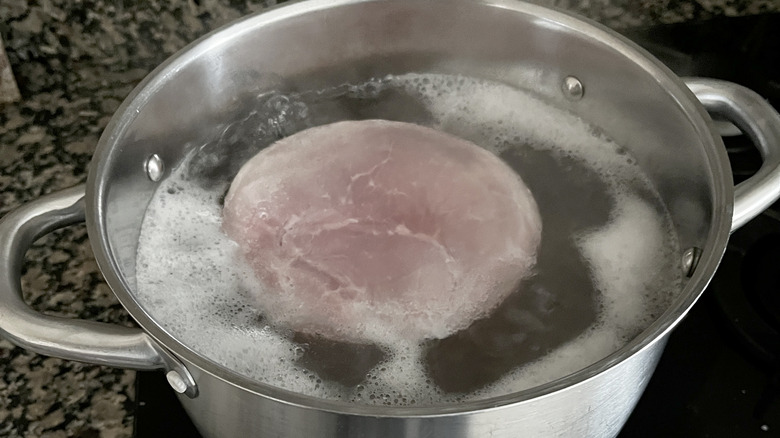The Soaking Trick To Fix Salty Store-Bought Ham
Store-bought ham is a life-saver for many cooks and eaters alike. Not only do you get a huge amount of tasty pork at a budget-friendly price, but most of it also comes pre-cooked, making preparation a breeze (roasting pre-cooked pork is easier than cooking the fresh version from scratch). The only caveat is ending up with an overly salty ham. Thankfully, there's an easy fix: soaking it in water.
This method is quite simple and mostly hands-off. First, remove the ham from its packaging and place it in a large bowl. Fill the bowl with cold water to completely cover the ham, then put the whole setup in the refrigerator. Leave it there for four to 12 hours (or more). Changing the water every few hours will also enhance this process. Once the time is up, remove the ham from the water and pat it dry with paper towels, then proceed to cook and serve your pork dish as usual. You'll notice a significant reduction in the salty taste.
Now, even though there's a solution to fix your ham's flavor, it's advisable to buy the right kind from the get-go. As much as possible, avoid any ham products labeled "Ham and Water Product," "Ham, Water Added," or "Water and Ham Product," as they contain very high levels of salt. To be on the safe side, always read the product labels before buying store-bought ham and only go for one with a lower sodium content.
How the soaking trick works
Before digging into the science behind soaking ham to fix saltiness, let's briefly address where it's coming from and why it's so prone to over-saltiness. Ham was first invented for the sole purpose of preserving the meat. This was done by dry curing or dipping the meat in brining solutions, which contain salt and other ingredients. The large quantities of salt required for this process means it's easy to end up with this result. Today, even after the invention of modern preservation techniques like refrigeration, cured pork continues to be consumed the world over thanks to its unique savory flavor. So how does soaking a salty ham make it less salty?
One way this water bath works is by washing away salt on the surface of the ham. Additionally, the lengthy stay in water also gives a chance for any salt inside the ham to leach out and get into the surrounding water. This explains why it helps to replace the soaking water every few hours in order to have a fresh batch with more capacity to draw out the salt from the meat. The saltier the ham is (e.g. country ham), the more time it'll need to soak in water to reduce that taste. That said, there's another way to speed up this de-salting process that involves the application of some heat. Enter the poaching method.
The poaching method
The poaching method essentially involves simmering the ham to reduce the salty taste. First, remove the ham from its packaging and cut it into a couple pieces. The goal is to increase the surface area of the pork that comes in contact with the boiling water, which increases the rate of salt leaching out of meat. However, you don't want to cut it into too small of pieces because those can easily fall apart during boiling. That's also why this method isn't ideal for pre-sliced ham.
Put the ham pieces in a large pot, add water until the meat is completely submerged, and place it on a stovetop. Some cooks even add Coca-Cola or ginger ale to the water alongside some spices like cloves to enhance the flavor of the liquid since you can use it later. These are optional additions, so feel free to stick to plain water, which is all you need to fix the ham's taste. Let it boil for about 30 minutes to one hour. Remove the meat from the poaching liquid and rinse with cold water. Pat dry the surface and proceed to cook your ham as usual. After boiling, your poaching liquid has now acquired subtle flavors from the pork and is therefore a kind of broth. You can use it as a base for your favorite vegetable soup or to make gravy for serving with your ham.


